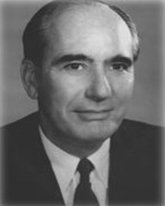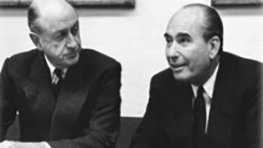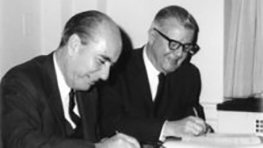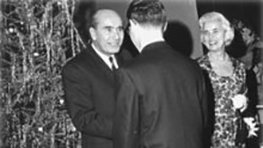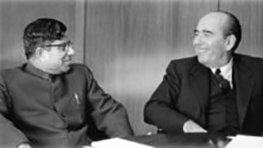4th President of the World Bank Group, January 1, 1963 - March 31, 1968
Woods oversaw the evolution of the Bank from a primarily conservative financial institution to a development institution by redirecting its focus and resources to the analysis of development and the support of more relevant economic activities. He emphasized the importance of IDA, and pushed for an increase in the Bank's level of activity. His "grand assize" represented the larger, global role of the Bank in correcting the disparity between rich and poor, North and South. His successors would further elaborate the scope of the Bank's activities in its global position.
Personal History
George Woods was born in Boston in 1901. After high school he entered the work force as an office boy at Harris, Forbes & Co., a leading underwriter of municipal and utility bonds. He quickly made his talents evident, and the company's senior executives persuaded him to attend night school in banking and finance. He became a buyer in the underwriting department, and at age 26 was promoted to vice president responsible for major projects. In 1930 the firm was acquired by Chase Bank, and Woods was made vice president of the new firm; he later became vice president and member of the board of First Boston Corporation, a newly formed securities company.
First Boston became one of America's largest investment banking firms, and Woods played a major role in the firm's most successful bond issues. In 1947 he became one of two executive vice presidents, in 1948 chairman of the executive committee and in 1951 chairman of the board. Woods became an acknowledged master of corporate finance because he was innovative and not limited by conventions in dealing with the problems.
Emphasis on Development
Woods oversaw the evolution of the Bank from a primarily conservative financial institution to a development institution by redirecting its focus and resources to the analysis of development and the support of more relevant economic activities. Under Woods, the Bank analyzed the factors that hindered growth in developing countries.
Trade barriers and changing terms of trade limited export earnings and opportunities; heavy burdens of external debt; lack of diversification in the structure of production; weak institutions and shortages of skills; and economic and financial policies which failed to support effective mobilization and allocation of resources. Given the wide range of difficulties, Woods saw that the Bank would have to add new dimensions to both its lending and technical assistance activities.
In addition to strengthening the role of economists, Woods looked to strengthen the younger professional staff of the institution. The Bank had typically recruited staff in mid-career. But in 1963, the Junior Professional Program (later Young Professional Program) was instituted as a means of recruiting graduates from leading universities.
Development Agenda
Woods believed that the Bank needed early intervention in the development process and continue its involvement to the later stages. This belief led Woods to promote a more serious involvement by the Bank in agriculture - a sector in developing countries that predominated as an employer and a source of demand, and a vital resource in a world of sharply increasing population. While the Bank had previously supported large-scale investment projects such as irrigation, flood control and land clearance, Woods thought the Bank should be more involved in activities that had a direct impact on agricultural operations, such as land settlement, farm credit, livestock production, seed improvement, grain storage facilities, and training and extension work. Woods established two permanent missions in Africa (Nairobi and Abidjan), composed of specialists in agriculture and transportation
Woods' belief in early intervention also meant an increased emphasis on education as a focus for Bank lending. The Bank's first funding for education had occurred three months before Woods came to the Bank. Woods believed that secondary and vocational schools would have a rapid impact on development by providing middle-level manpower and specialists in agriculture, administration and other areas crucial to economic growth. He greatly increased the level of funding for educational projects, and by the end of 1967 the Bank and IDA had financed a total of $142.6 million for 18 different education projects. 80% of these projects came from IDA concessional funds, and 60% of these projects were for African countries.
Woods also emphasized the role of industry as a nucleus for stimulating economic development. He realized that the Bank's requirement for government guarantees for development projects could hinder private enterprise, and thus stressed an increased role for the International Finance Corporation (IFC), the Bank Group's private sector arm, in industrial investments. Accordingly, he transferred the industrial projects staff from the Bank to IFC, and directed that the Bank lend capital to IFC which could be used for investment in member countries without the need for a government guarantee. He called for larger commitments by the IFC, and for the IFC to make direct loans to its clients without equity features.
Woods considered the growth of population one of the major obstacles to economic development, but stopped short of claiming a role for the Bank in this field: "Each country, within the framework of its own culture and its own social values, must decide for itself whether and if so by what means to control population growth. The importance of this issue can hardly be overemphasized."
Mobilizing Resources
Woods came to the Bank with a clear sense of the important role the Bank would play in the development field. He recognized that the development problem was a uniquely economic problem, not only one of the many issues within the context of the East-West conflict. And he clearly recognized the impediments facing the Bank's poorest members. He believed that IDA, with its concessional lending terms, would play an increasingly important role in the World Bank Group.
But Woods saw the need for concessional lending as a responsibility for the entire Bank Group, not as an issue for IDA alone. He proposed that the Bank modify its terms of lending by extending the grace period and the maturity of loans to better match the requirements of extended project implementation periods and the slow attainment of borrower capacity.
Woods promoted the concept of aid coordination to provide more effective targeting of foreign assistance from various sources; the first year of Woods' presidency saw the creation of the first Bank-organized consultative group (for Colombia), and by 1967 there were eleven aid-coordinating groups in existence. He also recognized the need for close cooperation with the United Nations, and felt that the Bank should work closely with the specialized agencies such as the Food and Agriculture Organization (FAO) and the United Nations Educational, Scientific and Cultural Organizations (UNESCO). A cooperative agreement with the FAO in 1964 helped initiate a large number of IDA projects in the agriculture sector. The Bank also served as executing agency for a large number of UNDP-financed studies.
Woods realized that the burden of external debt as a major difficulty for developing countries. In his view the problem was not excessive borrowing (as long as the borrowing was put to productive uses), but the rate of interest and the structure of the debt. He appealed to donor countries to soften the terms of their assistance, and urged developing countries to act not according to internal politics or narrow self-interest, but to implement policies and conditions that would foster productive investment: ensuring political and financial stability, and reforming land tenure and tax systems. He believed that "the development process itself is essentially a matter of domestic effort, for which no amount of external help can be a substitute." In calling for structural reform, Woods served as advocate for the "structural adjustment" policies that the Bank promoted in the early 1980s.
Woods faced difficulties in expanding the Bank's borrowing in the U.S. capital market. Congressional opposition prevented the Bank from some borrowing in 1965. By the next year, the Bank was still facing difficulties raising funds, and Woods began to worry that the Bank might not be able to borrow the funds it needed to meet its obligations to its borrowers. Lending commitments declined from 1965 through the end of Woods' tenure, and at one point Woods briefly suspended all lending activity by the Bank.
The Grand Assize
In 1967 he spent a weekend with like-minded people to discuss these problems. The result of these discussions was the call for a commission of authoritative experts to examine the state of development and to propose to political leaders and the public at large the steps necessary for maintaining hope and progress. In an address to the Swedish Bankers Association in October 1967 Woods unveiled his proposal for a "Grand Assize" of experts to examine the development problem. Although this commission, headed by Lester Pearson of Canada, came into existence after Woods' departure from the Bank, Woods' sponsorship of this body and his linking it to the World Bank gave greater prominence than it may otherwise have had.
Investment Disputes
Woods recognized that the developing countries' needs could never be satisfied by the Bank and IFC by themselves, and that private foreign investment was essential. But many foreign investors were hesitant to become involved in some countries for fear of government expropriation of assets or other acts which discouraged private investments. Woods sought to overcome this hesitation by allaying investor fears. He embraced the proposal by Aron Broches, the Bank's general counsel, to establish a facility which could resolve investment disputes. In October 1966, the International Centre for Settlement of Investment Disputes (ICSID) was established, which provided much-needed assurance for foreign private investors.
Funding for IDA
Mobilizing resources for IDA was a challenge throughout Woods' tenure. He was in the Bank at the time of the first IDA replenishment in 1963, but by the mid-1960s development funding was stagnating at a time when the income of the industrial countries was rising and the capacity of the developing countries to absorb development financing was also increasing. He proposed a highly ambitious target for IDA's second replenishment ($1 billion annually), but this target met stiff opposition in the developed world, which, after the initial optimism of the early 1960s, was beginning to experience donor fatigue. Woods' personal negotiating style did not help: donors felt that he was playing them off against each other, and it was not until the responsibility for IDA negotiations was transferred from Woods to vice president Burke Knapp that the second replenishment of IDA (for $400 million per year) was agreed to.
India
India represented both the challenges and the successes of the development field. Woods had been fascinated by India since his time at First Boston, when he made several trips to India at the request of the World Bank for financing various projects, and his interest in the country remained high during his tenure at the Bank. One of the many measures related to India during Woods' tenure was the Supplemental Agreement to provide additional funding for the Indus Basin works in India and Pakistan.
In addition, Woods decided that the Bank should participate in a debt relief exercise. India was not in danger of default, but Woods saw that debt service absorbed a major portion of its export earnings and deprived the economy of badly needed foreign exchange. He placed up to $50 million of India's debt service payments on deposit in the Reserve Bank of India. The Bank participated with other creditors in the India Consortium in general debt relief. These actions were highly controversial, and the executive directors approved them with reluctance only two weeks before Woods left the Bank
But relations between India and the Bank were taking a down turn. India also became a target of the critics of foreign aid, who were becoming skeptical of the efficacy of foreign assistance. In response, Woods sent Bernard Bell to carry out a comprehensive review of the country's economy. The Bell Mission was met with little enthusiasm by the Indian government. Bell's report recommended many policy changes, including simplification of the elaborate controls system, the introduction of intensified agricultural production, and the devaluation of the Indian currency. In return, the mission supported India's request for addition assistance, especially quick-disbursing assistance.
Initially opposed to devaluation, Woods came to accept the recommendations of the Bell Report. In response to pressure from the Bank, the IMF, and the U.S. Treasury, India devalued the rupee in 1966. Through a combination of factors (the devaluation was too small, and it coincided with two serious droughts which required massive food imports and induced a sharp recession), the predicted improvements in the Indian economy did not materialize. The Indian government was furious: they deeply resented the criticism of their performance and the pressure to reform. The need to devalue was seen as a price to pay for needed foreign assistance, and when this assistance failed to materialize the Indian government and press blamed the Bank and Woods personally, an ironic turn considering Woods’ great love for, and interest in, the country.
